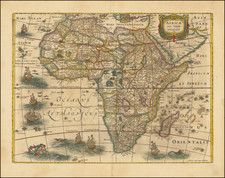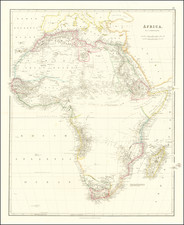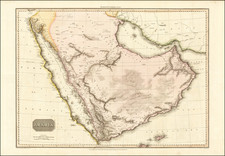Manuscript Map Showing Eighteenth-Century Dutch Contact with Australia
Striking manuscript map illustrating the tracks of the Jan en Cornelis, a ship subcontracted to the Dutch East India (VOC), in the Indian Ocean during a voyage between 1787 and 1789. A highly interesting and important map, it dates from the years in which the French and the English made their claims on the various parts of Australia, while the Dutch tried to safeguard their trading routes to and from the Dutch Indies.
The map focuses on the Indian Ocean, with Africa, the Arabian Peninsula, India, Southeast Asia and the western coast of Australia framing the sea. A compass rose sits in the middle of the waterway, with rhumb lines radiating out from it. Within mainland Africa is a detailed cartouche with the title, which includes the name of J. Duijff. As the VOC no longer used vellum charts after 1753, it is likely a passenger or crew member drew this chart while on board the Jan en Cornelis. Duiff perhaps singed the map as a witness, making the chart more official as a souvenir or a training document.
The chart includes several ship routes. Two lead round the Cape of Good Hope to Java. They show the two options for reaching Java depending on the monsoons. This chart unusually also includes a return voyage, a more direct line leading back round the Cape of Good Hope. As the return voyage is included, it is likely that the chart was made by a crew member who stayed with the ship, rather than a passenger that would have exited in Java.
Many names of the islands and coasts originally discovered by the Dutch in the seventeenth century are still indicated with their Dutch names, e.g. "Maerseveen" and "Dina", "Amsterdam" (Île Amsterdam) and "St. Paulo" (St. Paul Islands), "Monij" (Christmas Island), "I. Barbou" (Reunion) and, on the coast of Australia: "'t Land van Eendragt", "Edels Land", "'t Land van de Leeuwin", "Houtmans Ambrolhos", "Duijven Klip" and "Dirk Hartogs I". The last few toponyms are located in Australia and reflect over a century of Dutch contact with the west coast of that continent.
Early Dutch encounters with Australia
Whereas the Portuguese were the first Europeans to tap the lucrative resources of the East Indies, other European powers quickly joined the race. The VOC, founded in 1602, was based in Amsterdam with a local headquarters in Batavia (Jakarta). Dutch ships roved the waters of the Indian Ocean—the main focus of this manuscript map.
A few crossed the sea at southern latitudes, taking advantage of the winds of the roaring forties, which put them on a collision course with the continent of Australia, then still unknown to Europeans. These ships were following the Brouwer Route to Jakarta, so-called because it was explored in 1611 by Hendrick Brouwer. Less than five years later, it was named the prescribed route from the Cape of Good Hope to Java and following the route was compulsory for all VOC ships, unless they were destined directly for China and Ceylon, rather than Batavia.
Ships were supposed to turn north when they sighted Amsterdam Island or St. Paul Island, the spot where the two east-destined routes on this manuscript map split. However, the methods for calculating longitude in the seventeenth century were imprecise and some ships continued east, eventually running afoul of the Australian coast.
For example, “'t Land van de Leeuwin" as written on this chart is named for the Leeuwin, whose crew charted some of the southwest coastline in 1622. “Edels Land” is a reference to the navigator Jacob d’Edel. In 1619, d’Edel, in the Amsterdam, along with Frederik de Houtman in the Dordrecht came within sight of the western coast and called the stretch of land d’Edelsland. Houtman barely avoided a dangerous shoal on this voyage, which was henceforth called Houtman’s Abrolhos, or "Houtmans Ambrolhos" as written here.
Another example included here is the “’t Land van Eendragt”. The Eendracht was the second recorded European ship to contact Australia (1616). It was commanded by Dirk Hartog, of "Dirk Hartogs I". Hartog’s landing was the first recorded European landing on the western coast of Australia and the crew commemorated their discovery by erecting a post with a pewter dish inscribed with their ship’s information—the earliest physical record that historians have of any European landing in Australia. Hartog returned to tell of his feat to his employer, the VOC, and the feature entered maps as early as 1623 and was still in use at the end of the eighteenth century, as this map shows.
Klaas Duyff's VOC Voyage to Australia in 1787-1789
Based on information from a similar manuscript map held by the Maritime Museum Rotterdam, a ship called Jan en Cornelis, commanded by a Klaas Duyff, made a journey to Batavia and back between 1787 and 1789. The title of that map reads as follows: "Nieuwe Wassende Graadige Paskaart van de Groote Oceaan beneffens Een Route van het Schip Ian & Cornelis in den Jare 1787 en 1789 gedaan Uyt Nederlandt na Batavia". In a second cartouche on that map the draughtsman is identified: "Afgeteekend door My Iacob Duyff. me fecit G. Praater".
The map in the Maritime Museum Rotterdam shows part of the west of Africa and chronicles the outward and return journey up to the Cape of Good Hope; the route starts from the Channel and travels via the "Vlaamse Ylanden" to the Cape of Good Hope but breaks off in mid-sea to the east of Tristan da Cunha and St. Helena. A comparison of the map in the Maritime Museum Rotterdam with the map offered here shows that the two maps fit neatly to each other: the halves of the ships drawn on the western edge of the present map match almost exactly the halves of the ships drawn on the eastern edge of the map in the Maritime Museum Rotterdam.
Nothing could be traced on J. Duyff and the possible draftsman G. Praater, although research continues. However, www.VOCsite.nl supplies the following information about the two outward and return voyages made by the Jan en Cornelis under the command of Klaas Duyff:
· First journey was made from 1785-86, second journey from 1787-89
· The Jan en Cornelis was a "fluitschip" of 560 tons with a crew of 31 people.
· The Jan en Cornelis was leased by the VOC between 1785 and 1789 from the firm of Anselmus and Anthony Hartsen, and from shipowner Frank van der Schoor
Seal, Graham. The Savage Shore: Extraordinary stories of survival and tragedy from the early voyages of discovery. New Haven: Yale University Press, 2015.











![[Pakistan & India] Tabula Asiae IX](https://storage.googleapis.com/raremaps/img/small/94368.jpg)
![The Road of Palleacate off the Coast of Coromandell [with] The Road of Tengepatnam or Fort St. David on the Coast of Coromandell](https://storage.googleapis.com/raremaps/img/small/94807.jpg)
![(World War II - Free French Forces Mapping) Beyrouth Ville [Beirut City] [on verso:] Lattaquié [Latakia]](https://storage.googleapis.com/raremaps/img/small/88805.jpg)
